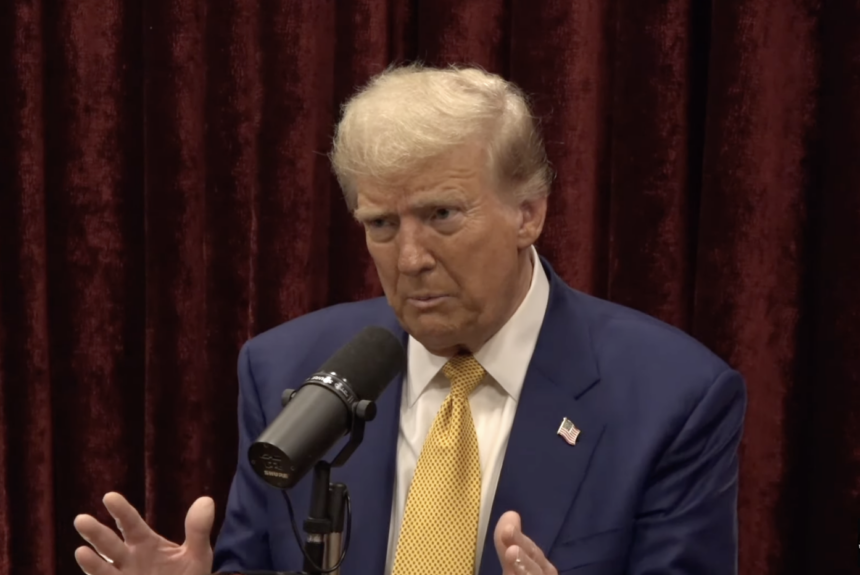In a lengthy interview with Joe Rogan, Donald Trump offered mixed reviews on nuclear power. While Trump praised nuclear energy for being clean, he warned of the costs and risks nuclear presents. The former president is partially correct. While overstating the danger and proliferation risks of nuclear, he pointed to burdensome regulations that inflate the cost of bringing new plants online.
When beginning the conversation on nuclear power (106:30), Rogan mentioned that nuclear power is the safest, cleanest form of electricity. He’s right. Whether it is lifecycle emissions or measuring death rates per terawatt-hour by energy source, nuclear power is among the safest forms of energy.
Rogan then mentioned Fukushima, Three Mile Island (TMI), and Chernobyl, saying that these incidents invoke fear. He also noted that these are “old systems, and they’re much more capable now.” This is partially correct. The Chernobyl plant was a flawed reactor design that would never be permitted in the U.S.
There was nothing wrong with the design of TMI or Fukushima. As I recently wrote with Bob Eccles in Real Clear Energy, “The 1979 partial meltdown of Three Mile Island Unit 2 occurred because of human error, not technical issues. Even so, background radiation in the area did not increase, and there were no deaths, injuries, or adverse environmental consequences.”
Fukushima survived a 9.0 earthquake and tsunami. We write that “the plant’s design and heroic actions by plant operators resulted in no immediate fatalities or widespread public radiation exposure or health effects on people or marine life. Only one fatality has been reported in connection with radiation exposure from a former plant worker who died of lung cancer in 2016.” Scientists have said the cancer may have not been due to radiation. Despite comments by Rogan and Trump that the area would be unhabitable for thousands of years, residents have returned.
Trump raised another supposed risk: the ability to turn nuclear energy into nuclear weapons. But that risk is dubious, at best. Eccles and I write: Despite the growth of commercial nuclear power to more than 400 plants worldwide, there is little evidence that the availability of nuclear energy results in proliferation.
A 2017 article in MIT’s International Security Journal found, ‘ A systematic analysis of the historical evidence suggests that the link between nuclear energy programs and proliferation is overstated. Although such programs increase the technical capacity of a state to build nuclear weapons, they have essential countervailing political effects that limit the odds of proliferation.’
Nuclear weapons possessed by hostile actors always pose a threat. But no uranium traded for commercial nuclear has been used in a nuclear weapon, and nuclear weapons programs that exist today grew independently from the civilian nuclear industry. It would be tough to procure any fuel from a power plant to make a nuclear weapon, let alone transport it to a facility for the enormous degree of enrichment that would be necessary (from around five percent to 85 percent or more) in quantities large enough to make a bomb.”
One of Trump’s more accurate points was on the cost of bringing new plants online and the regulations that escalate those costs. He cited the Vogtle plant in Georgia, which cost over $30 billion to build, came online seven years late and was $17 billion over budget. Even in the case of Vogtle, costs escalated because of an incomplete design, fractured supply chains, and an inexperienced workforce. Costs declined 30 percent from Vogtle Unit 3 to Unit 4.
Other expensive, ineffective regulations force nuclear operators to comply with environmental standards for no public health benefit. Furthermore, nuclear power must comply with “nuclear grade” steel, rebar, and concrete even though these materials provide no quality or national security benefits. As Brian Potter of the Institute for Progress points out, bureaucracy and red tape can increase the cost of these materials by as much as 50 times. Protracted environmental reviews and licensing processes increase expenses and timelines for project developers and create uncertainty for new, innovative technologies.
Rogan and Trump correctly say that newer, smaller nuclear technologies offer several advantages. Many of these reactors are built in a factor rather than on-site, which could reduce cost overruns and delays. Trump is wrong to say this is the way France pursued nuclear energy when he says France uses “small, little, compact plants.” France receives 70 percent of its electricity from nuclear power, but it does so through the large, 1000-megawatt reactors similar to what the U.S. has in operation.
Significantly, picking one reactor design, large or small, would stunt innovation in the nuclear industry. A wide range of small modular reactor (SMR) technologies is emerging. The International Atomic Energy Agency reports that there are 80 SMR designs and concepts globally. These reactors come in many different designs and sizes, from 5-megawatt microreactors to 300-megawatt designs. The market, not the federal government, should determine the fate of these technologies. Public policy should be technology-neutral, risk-informed, and performance-based. Compared to overly prescriptive licensing permitting, a more flexible process would allow a variety of technologies to compete and meet consumers’ needs while ensuring public health and safety.
The 2024 GOP Platform says it will unleash energy production from all sources, including nuclear. If that’s the case, fearmongering about the dangers of nuclear power with unsubstantiated claims is not going to help. Fixing the policies and regulations that make nuclear power less competitive in the marketplace will.
The views and opinions expressed are those of the author’s and do not necessarily reflect the official policy or position of C3.
